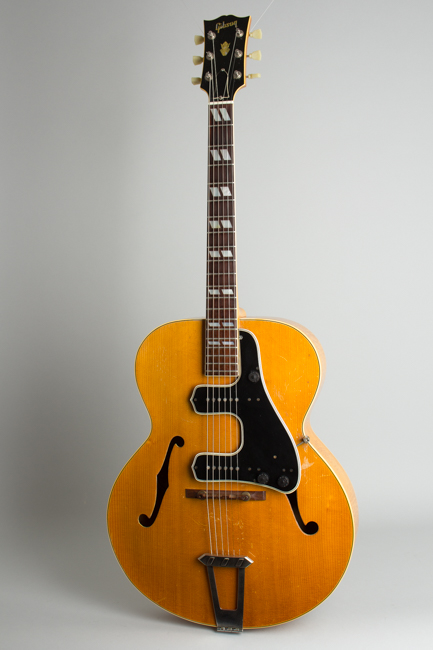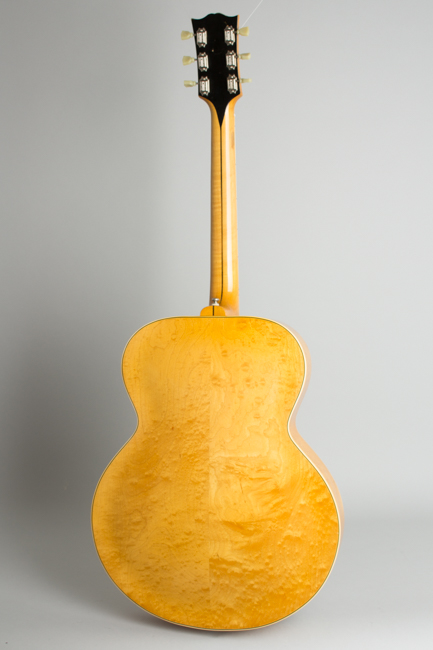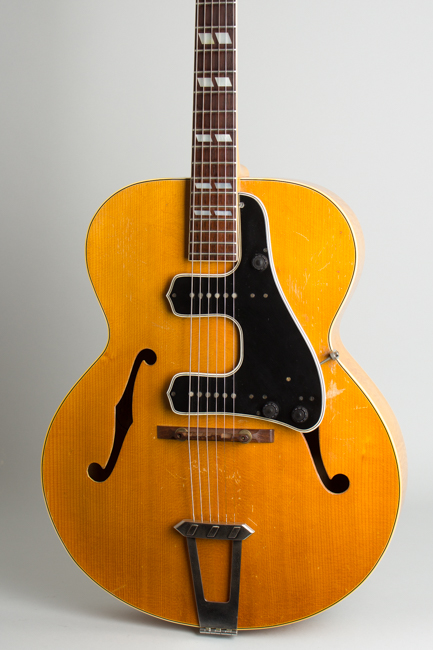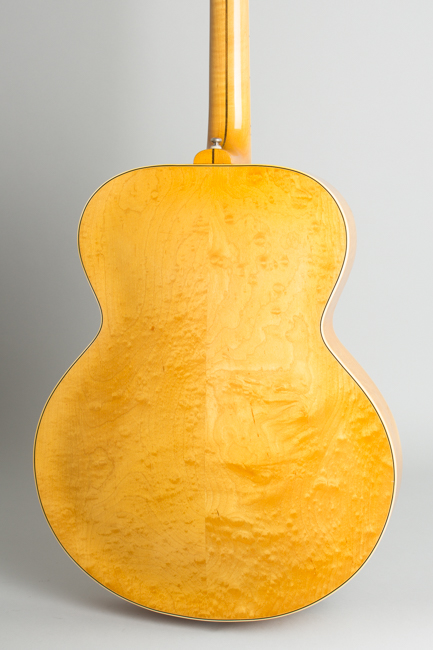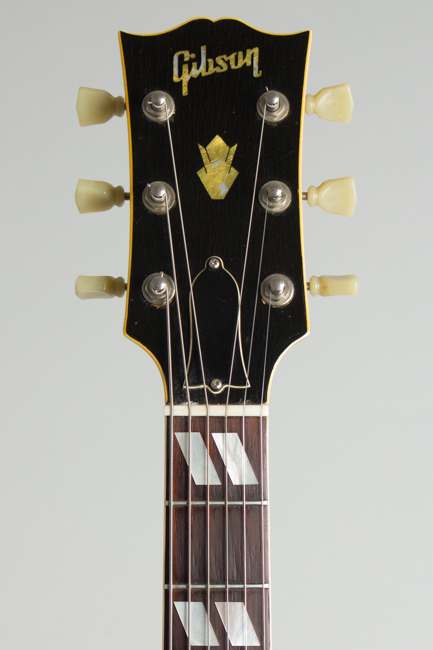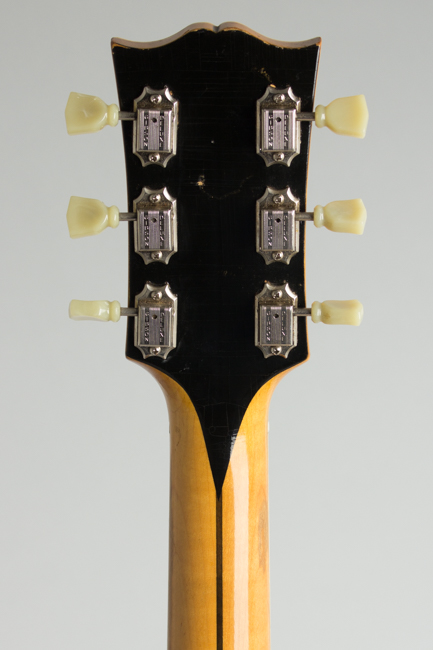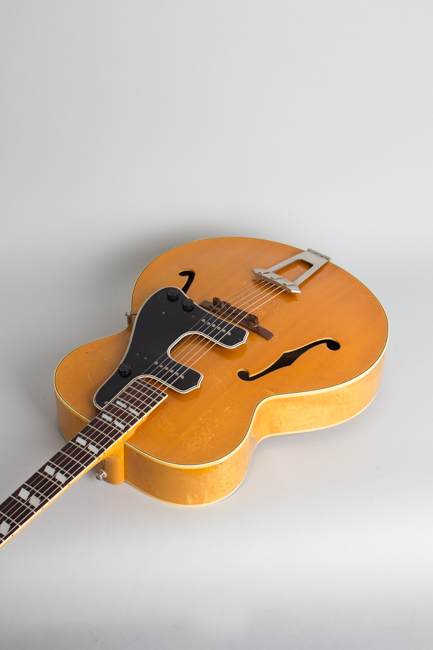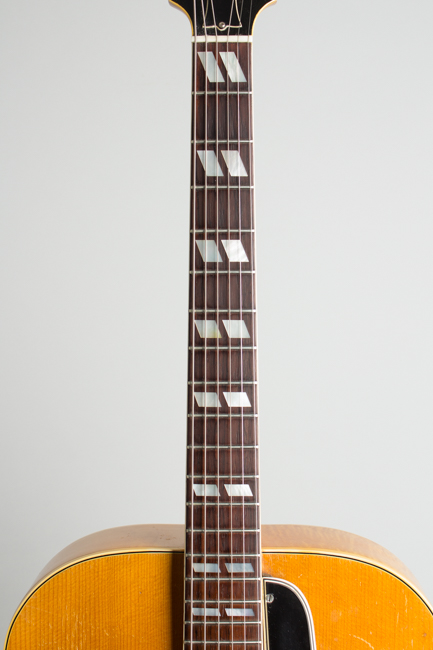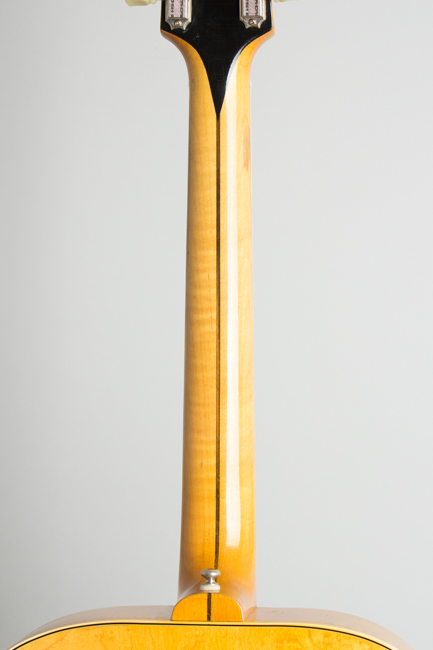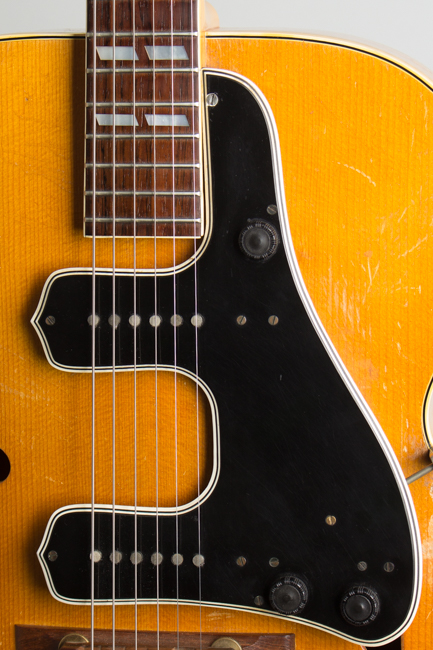Gibson L-7N Arch Top Acoustic Guitar (1951)
This item has been sold.
Item # 9068
Prices subject to change without notice.
Gibson L-7N Model Arch Top Acoustic Guitar (1951), made in Kalamazoo, Michigan, serial # A-7956, natural lacquer finish, maple body, spruce top, laminated maple neck with rosewood fingerboard, black hard shell case.
This well-played early 1950s L-7N is a lovely example of an acoustic 17" arch-top guitar fitted with the rare "Double McCarty" pickup rig, a fairly rare electrification offering from Gibson. This L-7N has a beautifully ambered natural finish and shows features typical for the period. The top is finely carved spruce and the rim and back are solid maple, with a nice burl figure on the back. The neck and headstock are single-bound, with triple binding on the body. The neck is maple with a center laminate ebony strip and rosewood fingerboard. The pearl fingerboard inlay is a double parallelogram pattern with Gibson's traditional pearl crown on the headstock. The solid-base adjustable rosewood bridge and hinged nickel-plated tailpiece are standard early 1950s fittings.
The white Gibson "artist" label inside the body indicates a shipping date in June 1951, one of only 54 L-7Ns shipped that year. At the time Gibson's output was becoming more dominated by electric instruments as the acoustic archtops the company pioneered lost favor with "modern" players. The L-7 was nowhere near the top of the line but is still a great solid wood arch-top perfectly at home in its original unplugged mode or amplified. This model is well on par with many more expensive carved-top instruments, a fully professional instrument then and now.
The pickguard/pickup assembly fitted to this guitar is a rare and interesting period Gibson innovation, their answer to the DeArmond "guitar mike" pickup, extremely popular at the time to amplify their acoustic archtops. Gibson wanted a piece of the action, and this became one of new president Ted McCarty's first jobs after arriving at the company. The patent application was filed in his name in November 1948, and Gibson offered single and double pickup versions. This unit does DeArmond one better by integrating the pickup, controls, and pickguard into one unit which can be easily removed if desired.
The pickups actually sound very good but in practice never seriously challenged DeArmond, and Gibson found much greater success building dedicated electric guitars. The fingerrest unit has since become known as the "McCarty Pickup" and was officially available for any Gibson archtop, but only offered as a stock appointment on several versions the L-7. The rarer double-pickup assembly may be original to this instrument although the label reads only L-7N, but is certainly period.
Overall length is 42 in. (106.7 cm.), 17 in. (43.2 cm.) wide at lower bout, and 3 1/2 in. (8.9 cm.) in depth, measured at side of rim. Scale length is 25 1/2 in. (648 mm.). Width of nut is 1 3/4 in. (44 mm.).
This lovely L-7 shows some wear and tear but remains largely original and a superb-sounding guitar both acoustically and in electric mode. The finish shows dings, dents, and scrapes, most notably to the top. There is a fairly large mark under the pickguard jack from many pluggings and unpluggings over the decades. All hardware appears original or at least correct except the tuners, which are the proper style but from the 1970s. There have been several tailpieces on the guitar over the years but the correct style hinged nickel plated unit is now back on.
The original screw-on jack to the pickup unit has been replaced with a standard phone jack. The only other alteration to the guitar is a strap button on the heel. It has been refretted with slightly larger wire and plays very well with a wonderful sound both acoustically and amplified. The McCarty pickup works quite well and the shallow coils with solid magnet poles have an different tonality than other Gibson pickups, offering a more transparent sound. The controls are individual volume knobs with a master tone and have less interaction than most Gibson designs, allowing for flexible pickup blending combinations. An interesting variation on a Gibson classic, housed in a well-worn but functional 1960s Guild case. Very Good + Condition.
This well-played early 1950s L-7N is a lovely example of an acoustic 17" arch-top guitar fitted with the rare "Double McCarty" pickup rig, a fairly rare electrification offering from Gibson. This L-7N has a beautifully ambered natural finish and shows features typical for the period. The top is finely carved spruce and the rim and back are solid maple, with a nice burl figure on the back. The neck and headstock are single-bound, with triple binding on the body. The neck is maple with a center laminate ebony strip and rosewood fingerboard. The pearl fingerboard inlay is a double parallelogram pattern with Gibson's traditional pearl crown on the headstock. The solid-base adjustable rosewood bridge and hinged nickel-plated tailpiece are standard early 1950s fittings.
The white Gibson "artist" label inside the body indicates a shipping date in June 1951, one of only 54 L-7Ns shipped that year. At the time Gibson's output was becoming more dominated by electric instruments as the acoustic archtops the company pioneered lost favor with "modern" players. The L-7 was nowhere near the top of the line but is still a great solid wood arch-top perfectly at home in its original unplugged mode or amplified. This model is well on par with many more expensive carved-top instruments, a fully professional instrument then and now.
The pickguard/pickup assembly fitted to this guitar is a rare and interesting period Gibson innovation, their answer to the DeArmond "guitar mike" pickup, extremely popular at the time to amplify their acoustic archtops. Gibson wanted a piece of the action, and this became one of new president Ted McCarty's first jobs after arriving at the company. The patent application was filed in his name in November 1948, and Gibson offered single and double pickup versions. This unit does DeArmond one better by integrating the pickup, controls, and pickguard into one unit which can be easily removed if desired.
The pickups actually sound very good but in practice never seriously challenged DeArmond, and Gibson found much greater success building dedicated electric guitars. The fingerrest unit has since become known as the "McCarty Pickup" and was officially available for any Gibson archtop, but only offered as a stock appointment on several versions the L-7. The rarer double-pickup assembly may be original to this instrument although the label reads only L-7N, but is certainly period.
Overall length is 42 in. (106.7 cm.), 17 in. (43.2 cm.) wide at lower bout, and 3 1/2 in. (8.9 cm.) in depth, measured at side of rim. Scale length is 25 1/2 in. (648 mm.). Width of nut is 1 3/4 in. (44 mm.).
This lovely L-7 shows some wear and tear but remains largely original and a superb-sounding guitar both acoustically and in electric mode. The finish shows dings, dents, and scrapes, most notably to the top. There is a fairly large mark under the pickguard jack from many pluggings and unpluggings over the decades. All hardware appears original or at least correct except the tuners, which are the proper style but from the 1970s. There have been several tailpieces on the guitar over the years but the correct style hinged nickel plated unit is now back on.
The original screw-on jack to the pickup unit has been replaced with a standard phone jack. The only other alteration to the guitar is a strap button on the heel. It has been refretted with slightly larger wire and plays very well with a wonderful sound both acoustically and amplified. The McCarty pickup works quite well and the shallow coils with solid magnet poles have an different tonality than other Gibson pickups, offering a more transparent sound. The controls are individual volume knobs with a master tone and have less interaction than most Gibson designs, allowing for flexible pickup blending combinations. An interesting variation on a Gibson classic, housed in a well-worn but functional 1960s Guild case. Very Good + Condition.
